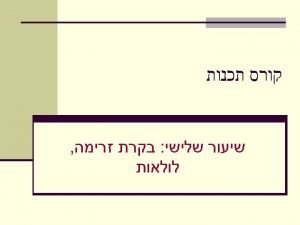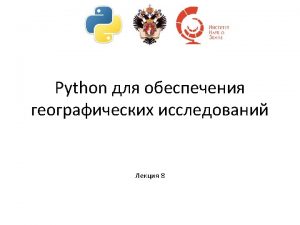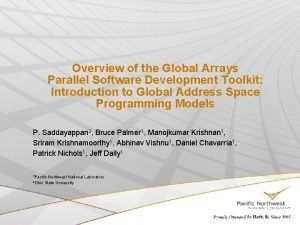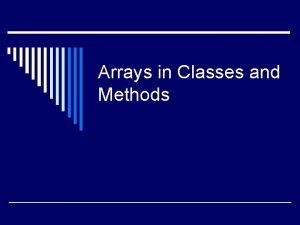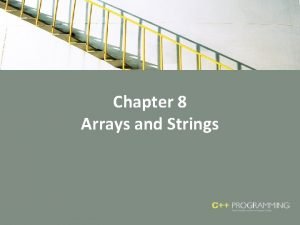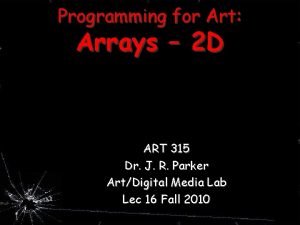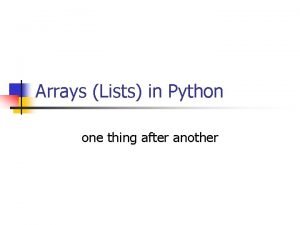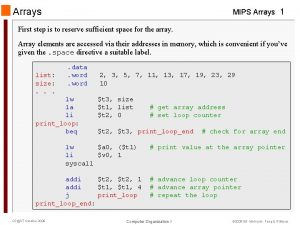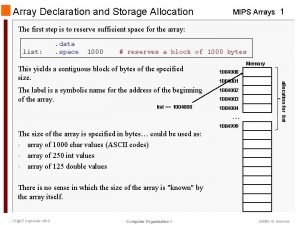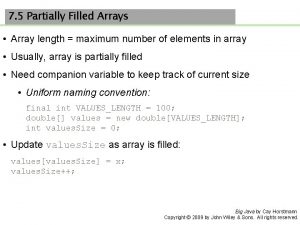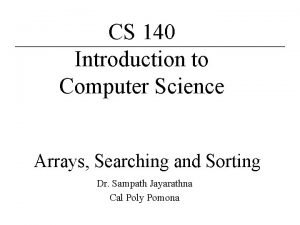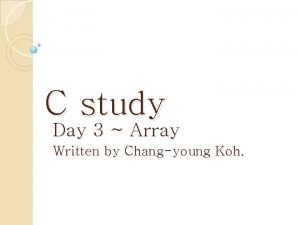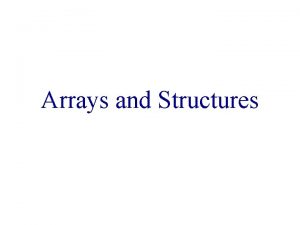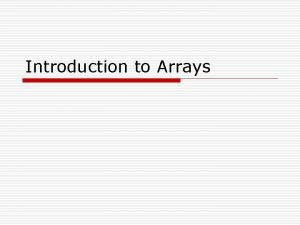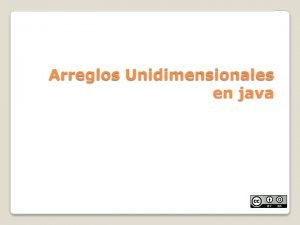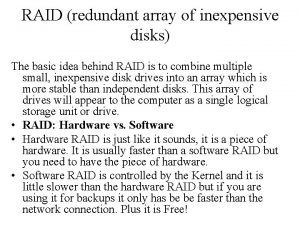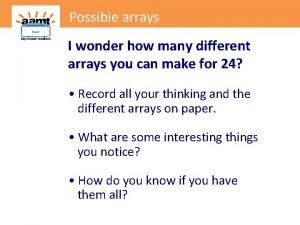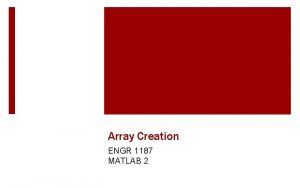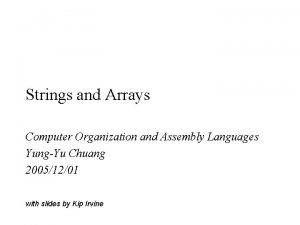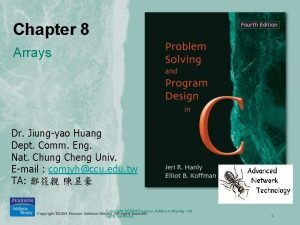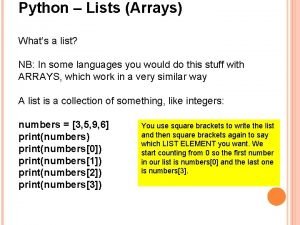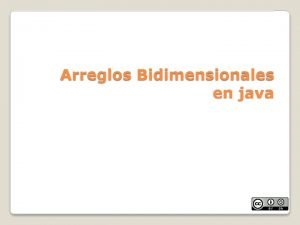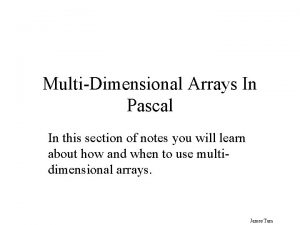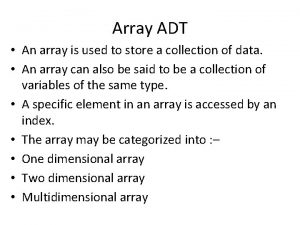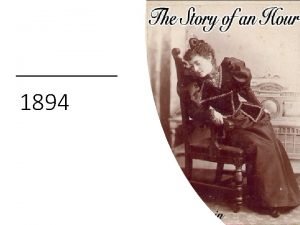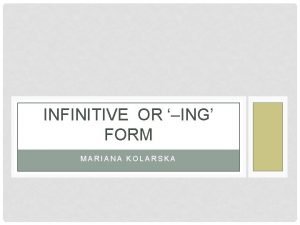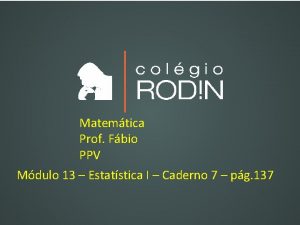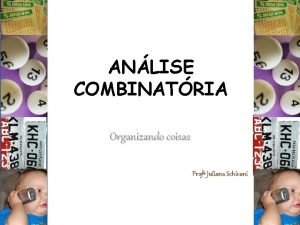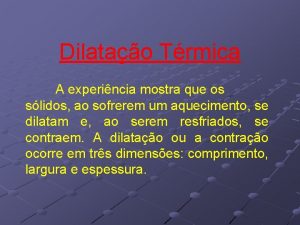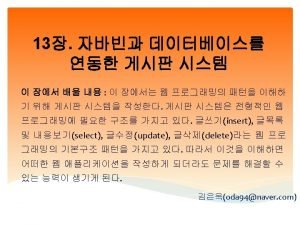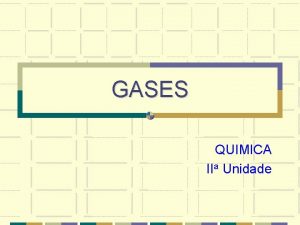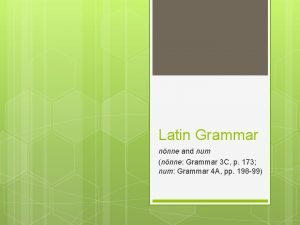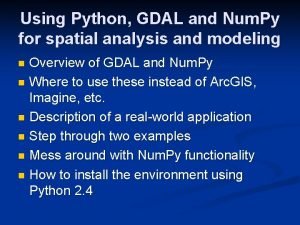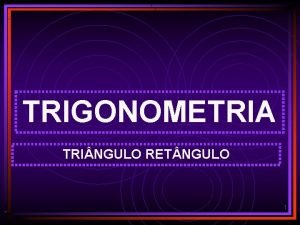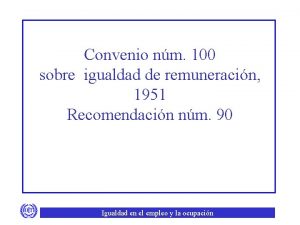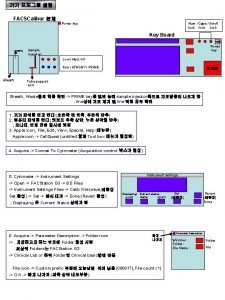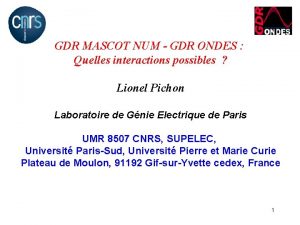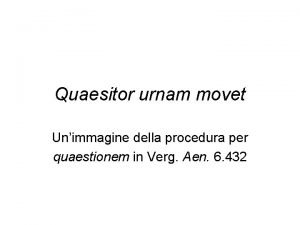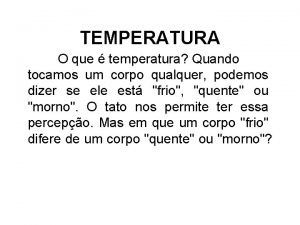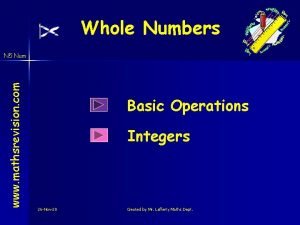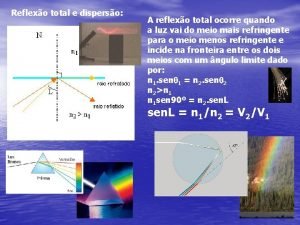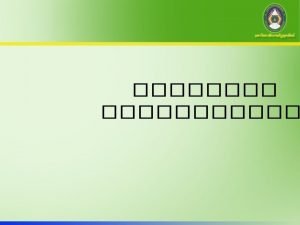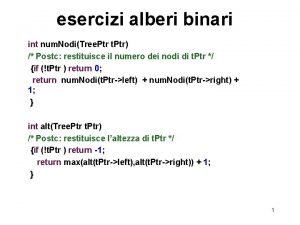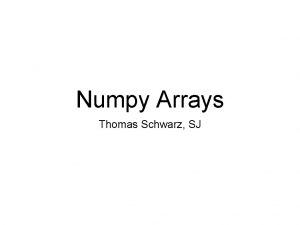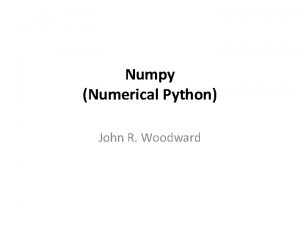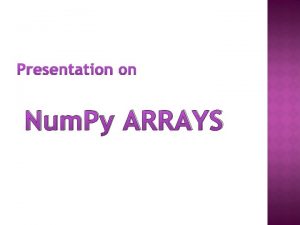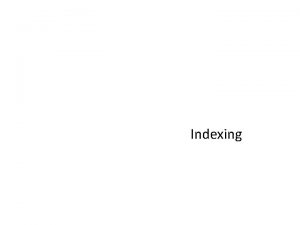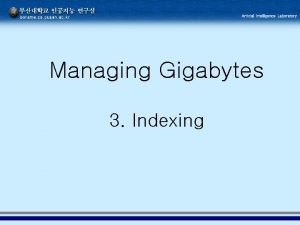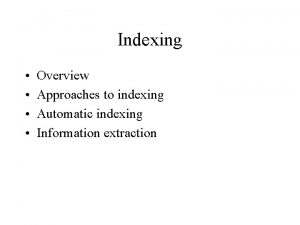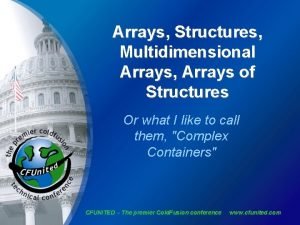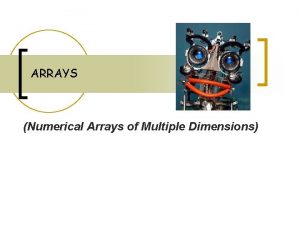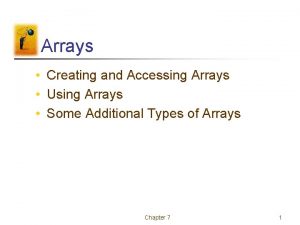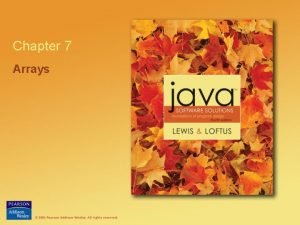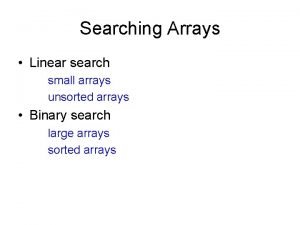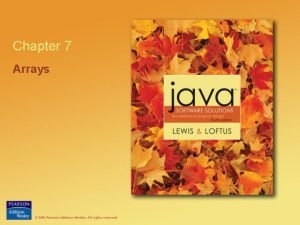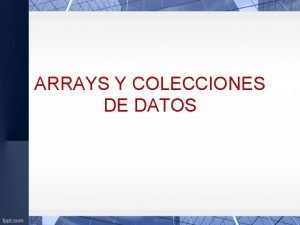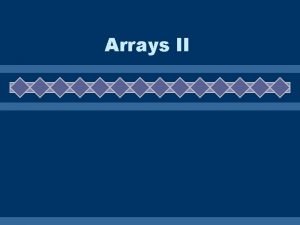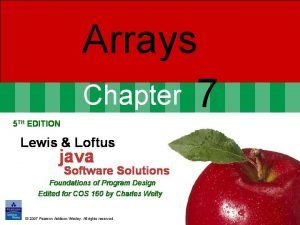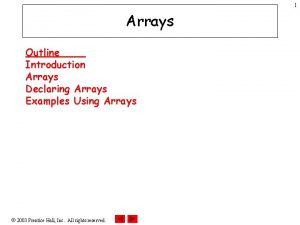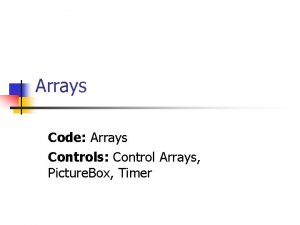Numpy Arrays Num Py Fancy Indexing Fancy indexing












![Simple Stats • Can determine percentiles and quantiles >>> iris[: 5, : ] array([[5. Simple Stats • Can determine percentiles and quantiles >>> iris[: 5, : ] array([[5.](https://slidetodoc.com/presentation_image_h2/4cd87295a9b27ecc97f533475b1f820e/image-13.jpg)



![Broadcast Application • Now we can use broadcasting >>> v[: , None]-v[None, : ] Broadcast Application • Now we can use broadcasting >>> v[: , None]-v[None, : ]](https://slidetodoc.com/presentation_image_h2/4cd87295a9b27ecc97f533475b1f820e/image-17.jpg)























![k-means clustering • [1 1 0 0 0] Best results with k = 2: k-means clustering • [1 1 0 0 0] Best results with k = 2:](https://slidetodoc.com/presentation_image_h2/4cd87295a9b27ecc97f533475b1f820e/image-41.jpg)


































![Processing Iris • Example: >>> np. unique(iris[: , 1]) array([2. , 2. 2, 2. Processing Iris • Example: >>> np. unique(iris[: , 1]) array([2. , 2. 2, 2.](https://slidetodoc.com/presentation_image_h2/4cd87295a9b27ecc97f533475b1f820e/image-76.jpg)
![Processing Iris • Remember how to split? >>> iris[: , 1]<2. 45] array([[4. 5, Processing Iris • Remember how to split? >>> iris[: , 1]<2. 45] array([[4. 5,](https://slidetodoc.com/presentation_image_h2/4cd87295a9b27ecc97f533475b1f820e/image-77.jpg)
![Processing Iris • And how to count rows? >>> iris[: , 1]<2. 45]. shape Processing Iris • And how to count rows? >>> iris[: , 1]<2. 45]. shape](https://slidetodoc.com/presentation_image_h2/4cd87295a9b27ecc97f533475b1f820e/image-78.jpg)











![Testing • Let's implement the decision tree: def predict(element): if element[2] < 2. 45: Testing • Let's implement the decision tree: def predict(element): if element[2] < 2. 45:](https://slidetodoc.com/presentation_image_h2/4cd87295a9b27ecc97f533475b1f820e/image-90.jpg)

- Slides: 91

Numpy Arrays

Num. Py: Fancy Indexing • Fancy indexing: • Use an array of indices in order to access a number of array elements at once

Num. Py: Fancy Indexing • Example: • Create matrix >>> mat = np. random. randint(0, 10, (3, 5)) >>> mat array([[3, 2, 3, 3, 0], [9, 5, 8, 3, 4], [7, 5, 2, 4, 6]]) • Fancy Indexing: >>> mat[(1, 2), (2, 3)] array([8, 4])

Num. Py: Fancy Indexing • Application: • • Creating a sample of a number of points Create a large random array representing data points >>> mat = np. random. normal(100, 20, (200, 2)) • Select the x and y coordinates by slicing >>> x=mat[: , 0] >>> y=mat[: , 1]

Num. Py: Fancy Indexing • >>> >>> Create a matplotlib figure with a plot inside it fig = plt. figure() ax = fig. add_subplot(1, 1, 1) ax. scatter(x, y) plt. show()

Num. Py: Fancy Indexing

Num. Py: Fancy Indexing • Create a list of potential indices >>> indices = np. random. choice(np. arange(0, 200, 1), 10) >>> indices array([ 32, 93, 172, 134, 90, 66, 109, 158, 188, 3 • Use fancy indexing to create the subset of points >>> subset = mat[indices]

Num. Py: Fancy Indexing

Simple Stats • Recall iris data set • After normalization >>> iris array([[0. 2222, [0. 16666667, [0. 1111, [0. 08333333, [0. 19444444, [0. 30555556, [0. 08333333, [0. 19444444, [0. 02777778, 0. 625 , 0. 41666667, 0. 5 , 0. 45833333, 0. 66666667, 0. 79166667, 0. 58333333, 0. 375 , 0. 06779661, 0. 05084746, 0. 08474576, 0. 06779661, 0. 11864407, 0. 06779661, 0. 08474576, 0. 06779661, 0. 04166667], 0. 125 ], 0. 08333333], 0. 04166667],

Simple Stats • Calculate average along of all values >>> np. mean(iris) 0. 4483046924042686 • Much more important: calculate average along an axis >>> np. mean(iris, axis=0) array([0. 4287037 , 0. 43916667, 0. 46757062, 0. 457

Simple Stats • Simularly: np. min, np. max, np. median • • With version in case nan (not a value) is present Example: Normalizing the iris data set def normalize(array): maxs = np. max(array, axis = 0) mins = np. min(array, axis = 0) return (array-mins)/(maxs-mins)

Simple Stats • Or normalize to have mean 0 and standard deviation 1 def normalize. S(array): means = np. mean(array, axis = 0) stdevs = np. std(array, axis = 0) return (array - means)/stdevs
![Simple Stats Can determine percentiles and quantiles iris 5 array5 Simple Stats • Can determine percentiles and quantiles >>> iris[: 5, : ] array([[5.](https://slidetodoc.com/presentation_image_h2/4cd87295a9b27ecc97f533475b1f820e/image-13.jpg)
Simple Stats • Can determine percentiles and quantiles >>> iris[: 5, : ] array([[5. 1, 3. 5, 1. 4, 0. 2], [4. 9, 3. , 1. 4, 0. 2], [4. 7, 3. 2, 1. 3, 0. 2], [4. 6, 3. 1, 1. 5, 0. 2], [5. , 3. 6, 1. 4, 0. 2]]) ]) >>> np. percentile(iris, 5, axis=0) array([4. 6 , 2. 345, 1. 3 , 0. 2 ]) np. percentile(iris, 95, axis=0) array([7. 255, 3. 8 , 6. 1 , 2. 3 ])

Broadcast Application • Getting the difference matrix of a vector

Broadcast Application • Because of broadcast rules, this will not work >>> v = np. array([1, 2, 3, 4, 5, 6, 7]) >>> v - v. T array([0, 0, 0, 0])

Broadcast Application • But we can embed the vector into a two-dimensional vector in two different ways >>> v[None, : ] array([[1, 2, 3, 4, 5, 6, 7]]) >>> v[: , None] array([[1], [2], [3], [4], [5], [6], [7]])
![Broadcast Application Now we can use broadcasting v NonevNone Broadcast Application • Now we can use broadcasting >>> v[: , None]-v[None, : ]](https://slidetodoc.com/presentation_image_h2/4cd87295a9b27ecc97f533475b1f820e/image-17.jpg)
Broadcast Application • Now we can use broadcasting >>> v[: , None]-v[None, : ] array([[ 0, -1, -2, -3, [ 1, 0, -1, -2, [ 2, 1, 0, -1, [ 3, 2, 1, 0, [ 4, 3, 2, 1, [ 5, 4, 3, 2, [ 6, 5, 4, 3, -4, -3, -2, -1, 0, 1, 2, -5, -4, -3, -2, -1, 0, 1, -6], -5], -4], -3], -2], -1], 0]])

k-means clustering • Given a set of data, can we cluster it even if we do not know its structure?

k-means clustering • Guess a number of clusters and pick k arbitrary points

k-means clustering • Classify all points according to which of the points they are closest

k-means clustering • Calculate the mean of all the data points and set it as the new center

k-means clustering • Reclassify all the points according to their closeness to the new centers

k-means clustering • Now calculate the new centers of the groups

k-means clustering • Repeat: Classify according to closeness to the new centers

k-means clustering • Continue • The centers no longer move when points are no longer moved between different categories

k-means clustering • Implementation • Find starting points by random selection def cluster(data, k, limit): centers = data[ np. random. choice(np. arange(data. shape[0]), k, replace=False), for _ in range(limit): distances = ((data[: , None] - centers. T[None, : ])**2). sum(axis=1) classification = np. argmin( distances, axis=1) new_centers = np. array([data[classification==j, : ]. mean(axis=0) for j in r if np. max(np. abs(new_centers - centers)) < 0. 01: break else: centers = new_centers else: #loop did not end print('No convergence') return centers

k-means clustering • Enter a limited loop: def cluster(data, k, limit): centers = data[ np. random. choice(np. arange(data. shape[0]) for _ in range(limit): distances = ((data[: , None] - centers. T[None, : ]) classification = np. argmin( distances, axis=1) new_centers = np. array([data[classification==j, : ]. mea if np. max(np. abs(new_centers - centers)) < 0. 01: break else: centers = new_centers else: #loop did not end print('No convergence') return centers

• Use the previous trick to calculate the difference between all points and the centers def cluster(data, k, limit): centers = data[ np. random. choice(np. arange(data. shape[0]) for _ in range(limit): distances = ((data[: , None] - centers. T[None, : ]) classification = np. argmin( distances, axis=1) new_centers = np. array([data[classification==j, : ]. mea if np. max(np. abs(new_centers - centers)) < 0. 01: break else: centers = new_centers else: #loop did not end print('No convergence') return centers

• For each point, find the closest distance def cluster(data, k, limit): centers = data[ np. random. choice(np. arange(data. shape[0]) for _ in range(limit): distances = ((data[: , None] - centers. T[None, : ]) classification = np. argmin( distances, axis=1) new_centers = np. array([data[classification==j, : ]. mea if np. max(np. abs(new_centers - centers)) < 0. 01: break else: centers = new_centers else: #loop did not end print('No convergence') return centers

• The new centers are obtained by taking the mean of the points with a given classification def cluster(data, k, limit): centers = data[ np. random. choice(np. arange(data. shape[0]) for _ in range(limit): distances = ((data[: , None] - centers. T[None, : ]) classification = np. argmin( distances, axis=1) new_centers = np. array([data[classification==j, : ]. mea if np. max(np. abs(new_centers - centers)) < 0. 01: break else: centers = new_centers else: #loop did not end print('No convergence') return centers

• If the centers do not move, we are done def cluster(data, k, limit): centers = data[ np. random. choice(np. arange(data. shape[0]) for _ in range(limit): distances = ((data[: , None] - centers. T[None, : ]) classification = np. argmin( distances, axis=1) new_centers = np. array([data[classification==j, : ]. mea if np. max(np. abs(new_centers - centers)) < 0. 01: break else: centers = new_centers else: #loop did not end print('No convergence') return centers

• Possible to not have convergence • For production quality code: consider raising an exception def cluster(data, k, limit): centers = data[ np. random. choice(np. arange(data. shape[0]) for _ in range(limit): distances = ((data[: , None] - centers. T[None, : ]) classification = np. argmin( distances, axis=1) new_centers = np. array([data[classification==j, : ]. mea if np. max(np. abs(new_centers - centers)) < 0. 01: break else: centers = new_centers else: #loop did not end print('No convergence') return centers

• The loop stabilized, we are done def cluster(data, k, limit): centers = data[ np. random. choice(np. arange(data. shape[0]) for _ in range(limit): distances = ((data[: , None] - centers. T[None, : ]) classification = np. argmin( distances, axis=1) new_centers = np. array([data[classification==j, : ]. mea if np. max(np. abs(new_centers - centers)) < 0. 01: break else: centers = new_centers else: #loop did not end print('No convergence') return centers

k-means clustering • Final result

k-means clustering • This worked because I used normalvariate to generate points around (2, 4), (8, 1), and (6, 6)

k-means clustering • • What happens if we use a different k? k=5: A cluster gets arbitrarily split

k-means clustering • k=2 Two clusters get merged

k-means clustering • Let's try this out on the Iris data set • • We only keep the measurements We can normalize data using the min-max method def normalize(array): maxs = np. max(array, axis = 0) mins = np. min(array, axis = 0) return (array-mins)/(maxs-mins)

k-means clustering • Now we try clustering without normalizing • The first 50 are 'Setosa', the next 50 are 'Virginica', then 'Variegata' • Sample with k = 5: • [1 1 0 0 3 0 0] 1 1 0 0 1 1 0 3 Recognizes 'Setosa' cluster, but not the other two 1 1 4 3 1 1 4 0 1 1 0 3 1 1 0 0 3 1 0 4 0 1 4 4 0 1 0 0 3 1 4 4 3 1 0 2 3 1 2 4 3 1 0 4 3 1 4 4 0 1 2 0 0 1 4 2 3 1 4 4 3 1 0 3 3 1 4 0 0 1 0 3 3 1 4 3 3 1 0 3 0 1 4 4 3 1 0 3 3 1 4 3 3 1 0 3 0 1 0 0 0

k-means clustering • [2 2 0 1 1 2 2 0 0 1 0 0] With k = 3: looks a bit better, but still cannot recognize Virginia and Variegata 2 2 1 0 2 2 0 1 2 2 0 0 2 2 0 1 2 2 0 0 2 1 0 1 2 0 0 1 2 1 0 0 2 0 0 1 2 0 0 1 2 0 0 0 2 0 0 1 2 0 1 1 2 0 0 0 2 0 1 1 2 0 1 0 2 0 0 1 2 0 1 0 2 0 1 1
![kmeans clustering 1 1 0 0 0 Best results with k 2 k-means clustering • [1 1 0 0 0] Best results with k = 2:](https://slidetodoc.com/presentation_image_h2/4cd87295a9b27ecc97f533475b1f820e/image-41.jpg)
k-means clustering • [1 1 0 0 0] Best results with k = 2: 1 1 0 0 1 1 0 0 1 1 0 0 0 1 0 0 0 1 0 1 1 0 0 0 1 0 0 0 1 0 0 0 1 0 0 0 1 0 0 0

k-means clustering • [2 2 0 1 1 [1 1 0 0 2 [1 2 0 0 0 2 2 1 1 1 0 1] 1 1 2 2 2 0 0] 2 2 0 0 0] With mean-std normalization, results are more encouraging, but still not satisfactory 2 2 1 1 2 0 0 1 2 2 0 0 2 2 0 1 2 2 0 0 2 2 1 1 2 1 0 1 2 0 0 1 2 1 0 1 2 0 0 0 2 0 0 1 2 0 1 1 2 0 0 1 2 1 1 1 2 0 1 0 2 0 0 1 2 1 1 1 2 0 1 0 2 0 1 1 0 2 1 1 0 0 1 1 0 2 1 1 0 0 1 1 2 2 1 1 2 0 2 1 2 0 0 1 0 0 2 1 2 0 2 1 0 0 0 1 0 0 2 1 0 2 2 1 0 0 0 1 2 2 2 1 0 2 0 1 0 0 2 1 2 2 2 1 0 0 2 1 0 2 0 1 0 2 2 0 0 1 2 0 0 2 1 0 0 1 2 0 0 2 1 0 0 2 2 0 0 0 1 0 0 0 1 0 0 0 2 0 0 0 2 0 0 0 2 0 0 0 1 0 0 0

k-means clustering • With k = 2, we cluster into Setosa and not-Setosa [1 1 0 0 0 [0 0 1 1 1 1 0 0 0] 0 0 1 1 1] 1 1 0 0 1 1 0 0 1 1 0 0 1 1 0 0 1 1 0 0 1 0 0 0 1 0 0 0 1 0 0 0 1 0 0 0 1 0 0 0 1 0 0 0 1 0 0 0 1 0 0 0 1 0 0 0 1 0 0 0 1 0 0 0 1 0 0 0 0 0 1 1 0 0 1 1 0 0 1 1 1 0 1 1 1 0 1 1 1 0 1 1 1 0 1 1 1 0 1 1 1 0 1 1 1

k-means clustering • With k=4: still no separation [0 3 1 2 2 [2 2 0 0 0 [2 1 0 0 0 3 3 3 0 2 2 2 1 1] 2 2 0 0 0 1 0] 1 1 1 2 0 0 0] 3 0 2 1 0 3 1 2 3 0 1 2 0 0 1 2 3 3 1 1 3 0 1 2 0 3 1 1 3 0 2 2 3 3 2 1 2 0 2 1 1 0 1 1 2 0 2 1 2 0 1 1 1 3 1 1 2 0 1 2 2 0 1 1 1 0 2 2 2 3 1 2 2 0 1 2 1 0 1 1 2 0 2 2 2 3 1 2 1 0 1 2 2 0 0 2 2 1 3 2 2 1 1 2 2 1 3 2 2 1 1 2 2 0 3 2 2 0 0 2 0 1 3 2 0 1 0 2 1 1 0 2 0 0 0 2 1 1 3 2 0 1 3 2 1 1 3 2 0 1 0 2 1 1 1 2 1 1 3 2 1 1 0 2 0 0 0 2 1 1 0 2 0 3 0 2 1 0 0 2 1 3 1 2 1 1 3 2 0 3 3 2 1 0 0 2 1 3 1 2 1 0 0 1 2 0 0 2 1 0 0 3 1 0 0 2 2 0 0 1 1 0 0 1 2 0 0 2 1 0 0 2 2 0 0 1 0 0 0 3 0 0 0 2 0 1 0 2 1 0 0 2 0 0 0 2 1 0 0 2 0 1 0 0 0 2 0 0 0 1 0 0 0 2 0 0 0 3 0 0 0 1 0 0 0 2 0 0 0

k-means clustering • Morale: • With k-means clustering • • Definitely need to normalize data set Need to repeat method many times • Pick the one with the lowest sum of Euclidean distances

Decision Trees Thomas Schwarz, SJ

Decision Trees • One of many machine learning methods • • Used to learn categories Example: • The Iris Data Set • • Four measurements of flowers Learn how to predict species from measurement

Iris Data Set Iris Setosa Iris Virginica Iris Versicolor

Iris Data Set • Data in a. csv file • • Collected by Fisher One of the most famous datasets • Look it up on Kaggle or at UC Irvine Machine Learning Repository

Measuring Purity • Entropy • categories with proportions = (nr in Cat )/(total nr) • • Unless one of the proportions is zero, in which case the entropy is zero. High entropy means low purity, low entropy means high purity

Measuring Purity • Gini index • Best calculated as

Measuring Purity • Assume two categories with proportions and

Building a Decision Tree • A decision tree • Can we predict the category (red vs blue) of the data from its coordinates?

Building a Decision Tree • Introduce a single boundary Almost all points above the line are blue

Building a Decision Tree • Subdivide the area below the line Defines three almost homogeneous regions

Building a Decision Tree • Express as a decision tree

Building a Decision Tree • • • Decision trees are easy to explain • Can easily extend to non-numeric variables • • Tend do not be as accurate as other simple methods Might more closely mirror human decision making Can be displayed graphically and are easily interpreted by a non-expert Non-robust: Small changes in data sets give rise to completely different final trees

Building a Decision Tree • If a new point with coordinates (x, y) is considered • • Decision tree is not always correct even on the points used to develop it • • Use the decision tree to predict the color of the point But it is mostly right If new points behave like the old ones • Expect the rules to be mostly correct

Building a Decision Tree • How do we build decision trees • • Many algorithms were tried out and compared • Second rule: If decision rules are complex they are likely to not generalize First rule: Decisions should be simple, involving only one coordinate • E. g. : the lone red point in the upper region is probably an outlier and not indicative of general behavior

Building a Decision Tree • How do we build decision trees • Third rule: • Don't get carried away • Prune trees to avoid overfitting

Building a Decision Tree • Algorithm for decision trees: • Find a simple rule: • • Maximizes the information gain Continue sub-diving the regions • Stop when a region is homogeneous or almost homogeneous • Stop when a region becomes too small

Building a Decision Tree • Information Gain from a split: information measure before information measures in the split parts

Processing Iris • We need to read in iris. csv • The last component is a string, which now needs an encoding (but we can pick the encoding to be None for the default) • We cannot use the default float type for the components

Processing Iris • Using genfromtxt np. genfromtxt('. . /Classes 2/Iris. csv', usecols=(1, 2, 3, 4, 5), dtype = None, encoding = None, delimiter = ', ', converters = converters, skip_header=1) Skip first column

Processing Iris • Using genfromtxt np. genfromtxt('. . /Classes 2/Iris. csv', usecols=(1, 2, 3, 4, 5), We allow all data-types dtype = None, encoding = None, delimiter = ', ', converters = converters, skip_header=1)

Processing Iris • Using genfromtxt np. genfromtxt('. . /Classes 2/Iris. csv', usecols=(1, 2, 3, 4, 5), dtype = None, encoding = None, We use the default encoding delimiter = ', ', converters = converters, skip_header=1)

Processing Iris • Using genfromtxt np. genfromtxt('. . /Classes 2/Iris. csv', usecols=(1, 2, 3, 4, 5), dtype = None, encoding = None, It is comma separated delimiter = ', ', converters = converters, skip_header=1)

Processing Iris • Using genfromtxt np. genfromtxt('. . /Classes 2/Iris. csv', usecols=(1, 2, 3, 4, 5), dtype = None, encoding = None, delimiter = ', ', converters = converters, The first line is the header and skip_header=1) we skip it

Processing Iris • Using genfromtxt np. genfromtxt('. . /Classes 2/Iris. csv', usecols=(1, 2, 3, 4, 5), Here we can process the dtype = None, data per column encoding = None, delimiter = ', ', converters = converters, skip_header=1) Column 5 gets encoded converters={5: lambda astring: (0 if astring == 'Iris-setosa' else 1 if astring == 'Iris-versicolor' else 2)}

Processing Iris • The result of genfromtxt is a "structured array" • • Superseded by Pandas, so we do not look at it After websearch, find a function that converts a structured array into a normal np. array from numpy. lib. recfunctions import structured_to_unstructured iris = structured_to_unstructured( np. genfromtxt('. . /Classes 2/Iris. csv', usecols=(1, 2, 3, 4, 5), dtype = None, encoding = None, delimiter = ', ', converters = converters, skip_header=1))

Processing Iris • Here is the result array([[5. 1, [4. 9, [4. 7, [4. 6, [5. , 3. 5, 3. 2, 3. 1, 3. 6, 1. 4, 1. 3, 1. 5, 1. 4, 0. 2, 0. 0. 0. ], ], ], 5. 7, 5. 2, 5. 4, 5. 1, 2. 5, 2. 3, 1. 9, 2. 3, 1. 8, 2. 2. 2. ], ], ], ]]) … [6. 7, [6. 3, [6. 5, [6. 2, [5. 9, 3. 3, 3. , 2. 5, 3. 4, 3. ,

Processing Iris • For any slice of Iris, we need to count the types of Iris represented • As can be expected, there is a np. function that does it for us def counts(iris): return np. array( [np. count_nonzero(iris[: , -1]==0. 0), np. count_nonzero(iris[: , -1]==1. 0), np. count_nonzero(iris[: , -1]==2. 0)])

Processing Iris • Given a count, we need to calculate the Gini and the Entropy values def gini(array): cts = counts(array)/array. shape[0] return 1 -np. sum(cts**2) def entropy(array): cts = counts(array)/array. shape[0] entropy = 0 for ct in cts: if ct != 0: entropy -= ct*log(ct, 2) return entropy

Processing Iris • Example: • Gini and Entropy for the iris data set and for the subset without 'Iris-setosa' >>> gini(iris) 0. 666666667 >>> entropy(iris) 1. 584962500721156 >>> gini(iris[: , -1]!=0]) 0. 5 >>> entropy(iris[: , -1]!=0]) 1. 0

Processing Iris • Now we need to find the candidates for the cuts • np has a function that generates an array of unique, ordered values • • We generate this array for each column And then calculates the midpoints by hand def candidates(array, column): values = np. unique(array[: , column]) return [(values[i]+values[i+1])/2 for i in range(values. size-1)]
![Processing Iris Example np uniqueiris 1 array2 2 2 2 Processing Iris • Example: >>> np. unique(iris[: , 1]) array([2. , 2. 2, 2.](https://slidetodoc.com/presentation_image_h2/4cd87295a9b27ecc97f533475b1f820e/image-76.jpg)
Processing Iris • Example: >>> np. unique(iris[: , 1]) array([2. , 2. 2, 2. 3, 2. 4, 2. 5, 2. 9, 3. 1, 3. 2, 3. 3, 3. 7, 3. 8, 3. 9, 4. 1, >>> candidates(iris, 1) [2. 1, 2. 25, 2. 3499999996, 2. 95, 3. 05, 3. 1500000004, 3. 3499999996, 3. 45, 3. 55, 3. 75, 3. 8499999996, 3. 95, 2. 6, 2. 7, 2. 8, 3. 4, 3. 5, 3. 6, 4. 2, 4. 4]) 2. 45, 2. 55, 2. 6500000 3. 25, 3. 6500000004, 4. 05, 4. 15, 4. 300000
![Processing Iris Remember how to split iris 12 45 array4 5 Processing Iris • Remember how to split? >>> iris[: , 1]<2. 45] array([[4. 5,](https://slidetodoc.com/presentation_image_h2/4cd87295a9b27ecc97f533475b1f820e/image-77.jpg)
Processing Iris • Remember how to split? >>> iris[: , 1]<2. 45] array([[4. 5, 2. 3, 1. 3, 0. 3, [5. 5, 2. 3, 4. , 1. 3, [4. 9, 2. 4, 3. 3, 1. , [5. , 2. , 3. 5, 1. , [6. , 2. 2, 4. , 1. , [6. 2, 2. 2, 4. 5, 1. 5, [5. 5, 2. 4, 3. 8, 1. 1, [5. 5, 2. 4, 3. 7, 1. , [6. 3, 2. 3, 4. 4, 1. 3, [5. , 2. 3, 3. 3, 1. , [6. , 2. 2, 5. , 1. 5, 0. 1. 1. 1. 2. ], ], ], ]])
![Processing Iris And how to count rows iris 12 45 shape Processing Iris • And how to count rows? >>> iris[: , 1]<2. 45]. shape](https://slidetodoc.com/presentation_image_h2/4cd87295a9b27ecc97f533475b1f820e/image-78.jpg)
Processing Iris • And how to count rows? >>> iris[: , 1]<2. 45]. shape (11, 5)

Processing Iris • Now we want to figure out the values for a split • We introduce a threshold so that we do not create splits that are too small def evaluate(array, column, split_value, thrd=3): left = array[: , column] < split_value] right = array[: , column] > split_value] if left. shape[0] < thrd or right. shape[0] < thrd: return 0 return gini(array)left. shape[0]/array. shape[0]*gini(left) - right. shape[0]/array. shape[0]*gini(right)

Processing Iris • Evaluate for each column and each candidate split point >>> for x in candidates(iris, 2): print(x, evaluate(iris, 2, x)) 1. 05 0 1. 15 0 1. 25 0. 01826484 1. 35 0. 052757793764988126 1. 45 0. 12073490813648302 1. 55 0. 2182890855457228 1. 65 0. 2767295597484277 1. 799999998 0. 3137254901960784 2. 45 0. 333333334 3. 15 0. 3236284412755001 3. 4 0. 3059067626272451 3. 6500000004 0. 2831813576494428

Processing Iris • To find the best value, use np. argmax / np. argmin • Returns the index of the largest / smallest element def best(array, column): mps = candidates(array, column) best_index = np. argmax( [evaluate(array, column, x) for x in mps]) return (mps[best_index], evaluate(array, column, mps[best_index]))

Processing Iris • To find the best split, we need to find the best one for all four columns def overall_best(array): values = [best(array, column)[1] for column in range(4)] col = np. argmax(values) return col, best(array, col)[0], best(array, col)[1]

Processing Iris • Now that we have found good split points, we need to actually do the split • Here, we are using slices, so we do not create new np. arrays def split(array, column, value): return array[: , column] < value], array[: , column] > value]

Processing Iris • At this point, we can interactively use our function • Best split point: >>> overall_best(iris) (2, 2. 45, 0. 333333334) • We split: >>> l, r = split(iris, 2, 2. 45) • And have achieved partial purity • Because everything in l is setosa >>> gini(l) 0. 0 >>> gini(r) 0. 5

Processing Iris • Now we try to split r >>> overall_best(r) (3, 1. 75, 0. 3896940418679548) • Which gives somewhat impure components >>> rl, rr = split(r, 3, 1. 75) >>> gini(rl) 0. 16803840877914955 >>> gini(rr) 0. 04253308128544431 >>> rl. shape (54, 5) >>> rr. shape (46, 5)

Processing Iris • We split rl: >>> overall_best(rl) (2, 4. 95, 0. 08239026063100136) >>> rll, rlr = split(rl, 2, 4. 95) • We inspect and see that there is not much hope for further division

Processing Iris • We look at rr and find it almost pure so we stop

Processing Iris

Result • Petal length and width are best at separating types from matplotlib import pyplot as plt. figure(figsize = (5, 6)) plt. scatter( [el[2] for el in [el[3] for el in c='red' ) plt. scatter( [el[2] for el in [el[3] for el in c='blue' ) plt. scatter( [el[2] for el in [el[3] for el in c='green' ) plt. show() Iris if el[-1]==0], Iris if el[-1]==1], Iris if el[-1]==2],
![Testing Lets implement the decision tree def predictelement if element2 2 45 Testing • Let's implement the decision tree: def predict(element): if element[2] < 2. 45:](https://slidetodoc.com/presentation_image_h2/4cd87295a9b27ecc97f533475b1f820e/image-90.jpg)
Testing • Let's implement the decision tree: def predict(element): if element[2] < 2. 45: return 1 else: if element[3] < 1. 75: if element[2] < 4. 95: return 2 else: return 0

Testing • And see how it works on the test data, taken randomly from the set • • One confused element or 1/36 error rate Total: • Four confused elements out of 150
 #includestdio.h int main()
#includestdio.h int main() Num = num + 1
Num = num + 1 Num++ vs ++num
Num++ vs ++num Post-and pre-coordinate indexing techniques
Post-and pre-coordinate indexing techniques Contoh pengindeksan manual
Contoh pengindeksan manual Numpy.polynomial.polynomial
Numpy.polynomial.polynomial Import numpy as np
Import numpy as np Import numpy as np import matplotlib.pyplot as plt
Import numpy as np import matplotlib.pyplot as plt Import numpy
Import numpy Global arrays in c
Global arrays in c Facts about arrays
Facts about arrays Parallel arrays
Parallel arrays Arrays
Arrays Python find index of max
Python find index of max Arrays mips
Arrays mips Advantages of static memory allocation
Advantages of static memory allocation Mips arrays
Mips arrays Array of arrays c++
Array of arrays c++ Partially filled array java
Partially filled array java Computer science arrays
Computer science arrays Dynamic arrays and amortized analysis
Dynamic arrays and amortized analysis Why do we need arrays?
Why do we need arrays? Day 3: arrays
Day 3: arrays Disadvantages of random access memory
Disadvantages of random access memory Polynomial representation using array in c
Polynomial representation using array in c Microled arrays
Microled arrays Parallel arrays
Parallel arrays Redundancy array of independent disk
Redundancy array of independent disk Searching and sorting arrays in c++
Searching and sorting arrays in c++ Variables unidimensionales ejemplos
Variables unidimensionales ejemplos Redundant array of inexpensive disks
Redundant array of inexpensive disks I wonder is it possible
I wonder is it possible Creating arrays matlab
Creating arrays matlab Assembly array of strings
Assembly array of strings Are vectors dynamic arrays
Are vectors dynamic arrays Partially filled arrays
Partially filled arrays Python list of arrays
Python list of arrays Arrays visual basic
Arrays visual basic Arreglos bidimensionales java
Arreglos bidimensionales java Small basic array
Small basic array Pascal 2d array
Pascal 2d array Parallel arrays java
Parallel arrays java Adt of array
Adt of array Fancy face definition
Fancy face definition Her fancy was running riot along those days ahead of her
Her fancy was running riot along those days ahead of her Chapter 15 how to read literature like a professor
Chapter 15 how to read literature like a professor Us extra fancy
Us extra fancy Fancy going for a drink
Fancy going for a drink Ing
Ing Fancy land
Fancy land Int num;
Int num; Void func(int num)
Void func(int num) Num%2
Num%2 Uncisal num certo dia do mes de novembro
Uncisal num certo dia do mes de novembro Var num
Var num Num % 2
Num % 2 Eubulides de mileto
Eubulides de mileto Combinação e arranjo
Combinação e arranjo Uma chapa de zinco tem area de 8cm a 20c
Uma chapa de zinco tem area de 8cm a 20c Int num
Int num Int num
Int num Num god
Num god Um balão de borracha continha 3 litros de gás hélio
Um balão de borracha continha 3 litros de gás hélio Int num
Int num Num latin
Num latin Num py
Num py Havia um elfo encantado que morava num pé de caqui
Havia um elfo encantado que morava num pé de caqui Num vão entre duas paredes deve-se construir uma rampa
Num vão entre duas paredes deve-se construir uma rampa Int main() int num=4
Int main() int num=4 Convenio sobre igualdad de remuneración, 1951 (núm. 100)
Convenio sobre igualdad de remuneración, 1951 (núm. 100) Quem foi o profeta que voou no redemoinho
Quem foi o profeta que voou no redemoinho Num vs nonne
Num vs nonne O cidadão norte americano desperta num leito
O cidadão norte americano desperta num leito Int num
Int num Num 15
Num 15 ㄴㅊ개ㅣㅣㅣㄷㄱ.채ㅡ
ㄴㅊ개ㅣㅣㅣㄷㄱ.채ㅡ Num dia claro uma pessoa passa diante dos vidros
Num dia claro uma pessoa passa diante dos vidros Gdr mascot num
Gdr mascot num Quaero ex te, vatini
Quaero ex te, vatini Calorimetria
Calorimetria 5 num
5 num Int i
Int i Uma pessoa encontra se deitada num trampolim
Uma pessoa encontra se deitada num trampolim Int num
Int num Numbots diamond
Numbots diamond Esercizi alberi binari
Esercizi alberi binari Eletricidade dos corpos
Eletricidade dos corpos Data mining
Data mining Cuento de la letra f
Cuento de la letra f Oseias hijo de num
Oseias hijo de num Um radio emite ondas sonoras com potencia de 12w
Um radio emite ondas sonoras com potencia de 12w

